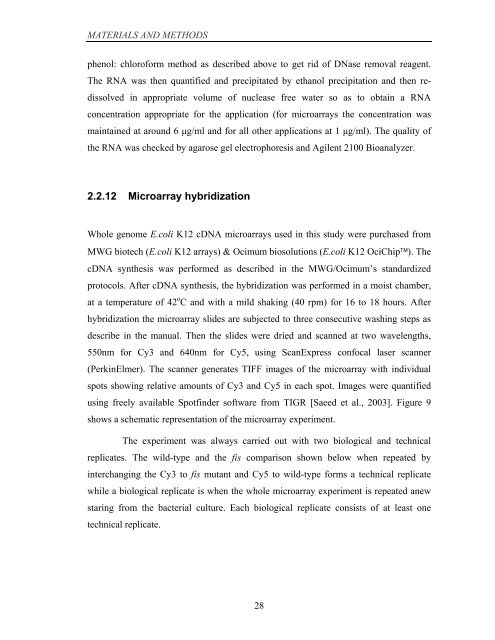Coordinated regulation of gene expression by E ... - Jacobs University
Coordinated regulation of gene expression by E ... - Jacobs University
Coordinated regulation of gene expression by E ... - Jacobs University
You also want an ePaper? Increase the reach of your titles
YUMPU automatically turns print PDFs into web optimized ePapers that Google loves.
MATERIALS AND METHODS<br />
phenol: chlor<strong>of</strong>orm method as described above to get rid <strong>of</strong> DNase removal reagent.<br />
The RNA was then quantified and precipitated <strong>by</strong> ethanol precipitation and then redissolved<br />
in appropriate volume <strong>of</strong> nuclease free water so as to obtain a RNA<br />
concentration appropriate for the application (for microarrays the concentration was<br />
maintained at around 6 μg/ml and for all other applications at 1 μg/ml). The quality <strong>of</strong><br />
the RNA was checked <strong>by</strong> agarose gel electrophoresis and Agilent 2100 Bioanalyzer.<br />
2.2.12 Microarray hybridization<br />
Whole genome E.coli K12 cDNA microarrays used in this study were purchased from<br />
MWG biotech (E.coli K12 arrays) & Ocimum biosolutions (E.coli K12 OciChip). The<br />
cDNA synthesis was performed as described in the MWG/Ocimum’s standardized<br />
protocols. After cDNA synthesis, the hybridization was performed in a moist chamber,<br />
at a temperature <strong>of</strong> 42 o C and with a mild shaking (40 rpm) for 16 to 18 hours. After<br />
hybridization the microarray slides are subjected to three consecutive washing steps as<br />
describe in the manual. Then the slides were dried and scanned at two wavelengths,<br />
550nm for Cy3 and 640nm for Cy5, using ScanExpress confocal laser scanner<br />
(PerkinElmer). The scanner <strong>gene</strong>rates TIFF images <strong>of</strong> the microarray with individual<br />
spots showing relative amounts <strong>of</strong> Cy3 and Cy5 in each spot. Images were quantified<br />
using freely available Spotfinder s<strong>of</strong>tware from TIGR [Saeed et al., 2003]. Figure 9<br />
shows a schematic representation <strong>of</strong> the microarray experiment.<br />
The experiment was always carried out with two biological and technical<br />
replicates. The wild-type and the fis comparison shown below when repeated <strong>by</strong><br />
interchanging the Cy3 to fis mutant and Cy5 to wild-type forms a technical replicate<br />
while a biological replicate is when the whole microarray experiment is repeated anew<br />
staring from the bacterial culture. Each biological replicate consists <strong>of</strong> at least one<br />
technical replicate.<br />
28
















